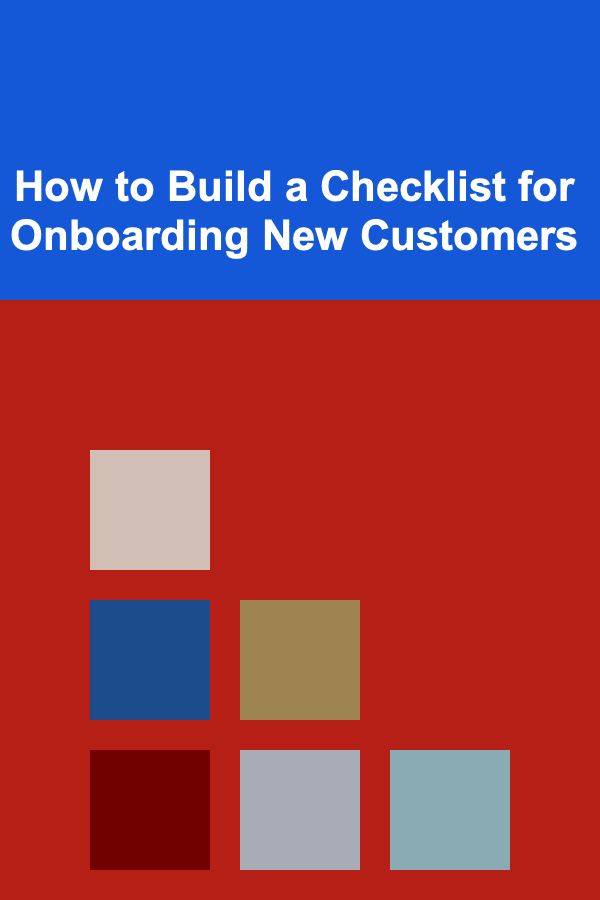
How to Build a Checklist for Onboarding New Customers
ebook include PDF & Audio bundle (Micro Guide)
$12.99$10.99
Limited Time Offer! Order within the next:

Onboarding new customers is one of the most important processes for any business, especially in service-oriented and SaaS (Software as a Service) industries. A smooth and well-organized onboarding process helps set the stage for long-term customer satisfaction, retention, and success. It's essential to make customers feel welcomed, supported, and confident from the very first interaction. One of the best ways to ensure this is through a structured onboarding checklist.
This guide provides a step-by-step approach to creating an effective onboarding checklist that will not only guide your customers through their initial experience with your product or service but also enhance their overall journey with your company.
Understand Your Customer's Needs and Expectations
Before jumping into the technical aspects of the onboarding process, the first step is to understand the specific needs and expectations of your customers. No two customers are alike, so tailoring the onboarding experience is key.
Action Steps:
- Segment Your Customers: Different customer segments may require different onboarding processes. For example, an enterprise customer might have more complex requirements than an individual user. Consider segmenting your customer base by size, industry, or use case.
- Ask Questions: When a new customer signs up, ask them a series of questions to understand their goals, pain points, and what they hope to achieve by using your product or service. This can be done through surveys, onboarding forms, or personalized calls.
- Define Success for Your Customers: Understand what success looks like for your customers. Are they trying to streamline a process, reduce costs, or improve efficiency? Knowing this will help you personalize the onboarding checklist to match their goals.
Key Consideration:
Understanding your customers' unique needs will enable you to create a more effective onboarding experience, ensuring that the process is relevant and useful.
Welcome the Customer and Set Clear Expectations
The first impression matters. As soon as a customer signs up or makes a purchase, they should feel valued. The initial phase of onboarding is about welcoming the customer and setting clear expectations for the journey ahead.
Action Steps:
- Send a Welcome Email: Immediately after the customer signs up or makes a purchase, send a personalized welcome email. This email should thank them for choosing your product or service, introduce your company, and explain what they can expect next.
- Provide a Product Tour: Offer a brief but informative tour of your product or service, highlighting key features that will help them get started. For SaaS businesses, this could be an interactive tutorial; for physical products, it could be a video or step-by-step guide.
- Clarify the Onboarding Process: Let the customer know how long the onboarding process will take, what steps are involved, and how they can get help along the way. Setting clear expectations helps reduce any uncertainty or frustration.
Key Consideration:
A welcoming, informative, and empathetic first communication can set the tone for the entire customer relationship, building trust and satisfaction from the start.
Provide Key Resources for Getting Started
Next, equip the customer with the resources they need to start using your product or service effectively. This could include guides, FAQs, video tutorials, or customer support contacts.
Action Steps:
- Create a Knowledge Base: Ensure your customer has access to a well-organized knowledge base or help center that answers common questions, provides how-to guides, and troubleshooting tips.
- Develop Quick-Start Guides: Provide a condensed version of your product's features, showcasing the most critical actions a new customer should take to get started quickly.
- Offer Training Resources: Depending on your product, providing webinars, training sessions, or one-on-one calls can be invaluable. These could be live or pre-recorded sessions that help the customer understand how to use your product or service in greater depth.
Key Consideration:
Offering easy-to-understand resources allows customers to independently find answers and become comfortable with your product, reducing frustration and support requests.
Implement Product Activation Steps
For SaaS or tech products, activation refers to getting the customer to use your product's core features that demonstrate its value. Product activation is a critical part of onboarding because it ensures that customers see tangible benefits from your product early on.
Action Steps:
- Identify Key Features: Determine which features are the most crucial for demonstrating the product's value. These might be features that are central to the customer's goals or the ones that they will use most frequently.
- Create Guided Steps: Walk your customer through a series of actions that help them set up these key features. This could involve setting up an account, configuring settings, uploading data, or linking integrations. These steps should be easy to follow and not overwhelming.
- Provide Feedback and Rewards: As the customer completes each key step, offer feedback, validation, or rewards to encourage continued progress. This can be done through confirmation messages, progress bars, or small incentives (like discounts or badges).
Key Consideration:
The more quickly a customer experiences the value of your product, the more likely they are to stay engaged and become a long-term user. Focus on the critical path to value from the customer's perspective.
Introduce Ongoing Support Options
Throughout the onboarding process, your customers may have questions, face challenges, or need assistance. A crucial aspect of the checklist should be offering them support options in a way that's easy to access and responsive.
Action Steps:
- Live Chat: Enable live chat or chatbots on your website or within the product so customers can easily reach out for help. This ensures that no matter what stage of onboarding they are in, they can get quick answers to any questions.
- Dedicated Account Manager or Support Team: For higher-tier customers, offer direct access to an account manager or a dedicated support team who can guide them through the process, answer questions, and resolve issues.
- Proactive Check-ins: Instead of waiting for the customer to reach out, periodically check in with them during the onboarding process. These check-ins can be automated emails or personal calls to ask how they're doing, offer assistance, and gather feedback.
Key Consideration:
A support system that is easily accessible and proactive shows customers that you care about their success. This can be the difference between a positive and a frustrating onboarding experience.
Collect and Act on Customer Feedback
Feedback is vital to understanding how well your onboarding process is working and where it can be improved. It allows you to make data-driven decisions to enhance the experience for future customers.
Action Steps:
- Survey New Customers: After the onboarding process, send a brief survey to collect feedback on the experience. Focus on questions like: What was helpful? What challenges did they face? How can the process be improved?
- Monitor Usage Data: For tech products, analyze user data to see how frequently customers are engaging with key features. This can help you identify where users drop off or where they struggle.
- Iterate Based on Feedback: Use the feedback and data you collect to iterate on your onboarding checklist. Continuously improve the process to ensure it meets the evolving needs of your customers.
Key Consideration:
By acting on feedback and using data to guide improvements, you ensure that your onboarding process evolves to stay relevant and effective, providing an increasingly smooth experience for new customers.
Set Up Long-Term Relationship Building
Onboarding doesn't end when the customer has completed the initial steps. The ultimate goal is to keep them engaged and invested in your product long after the onboarding process is complete.
Action Steps:
- Provide Ongoing Education: Offer ongoing education to help your customers get the most out of your product. This could include advanced tutorials, new feature announcements, or regular tips through emails or newsletters.
- Create a Community: Foster a community where users can interact with each other, share tips, and ask questions. This can be a forum, a Slack group, or a private Facebook group.
- Introduce Upsell and Cross-Sell Opportunities: As your customer becomes more comfortable with the product, introduce additional features, services, or upgrades that can enhance their experience and meet their evolving needs.
Key Consideration:
Nurturing long-term relationships with your customers, even after onboarding, helps maintain engagement, boosts customer retention, and opens up opportunities for future revenue.
Conclusion
Building a checklist for onboarding new customers involves more than simply walking them through a series of steps. It's about creating an experience that helps them feel confident, supported, and successful from the moment they engage with your product or service. By understanding your customers' needs, providing essential resources, and offering continuous support, you set the stage for a lasting, positive relationship.
An effective onboarding checklist should be dynamic and customizable to meet the unique needs of each customer segment. It should aim for simplicity, clarity, and value, ensuring that the customer's journey from sign-up to success is as smooth and beneficial as possible. By following the steps outlined in this guide, you'll build a stronger, more loyal customer base and foster an environment of long-term growth for your business.
Reading More From Our Other Websites
- [Organization Tip 101] How to Cultivate Relationships with Local Vendors for Events
- [Personal Financial Planning 101] How to Plan for a Comfortable Early Retirement
- [Screen Printing Tip 101] From Design to Fabric: Mastering Color Mixing and Layering in DIY Screen Printing
- [Toy Making Tip 101] Step-by-Step Guide: Printing, Assembling, and Painting DIY Action Figures
- [Home Rental Property 101] How to Set the Right Rent Price for Your Rental Property
- [Personal Financial Planning 101] How to Protect Your Finances from Inflation and Economic Uncertainty
- [Home Renovating 101] How to Modernize Your Home's Kitchen Appliances
- [Personal Care Tips 101] How to Decode Your Skin: A Face Serums Guide for Every Skin Type
- [Personal Investment 101] How to Make Your Investment Property Eco-Friendly
- [Star Gazing Tip 101] How to Start Your Own Star Gazing Club: A Step‑By‑Step Guide

How to Build a Checklist for Self-Assessment Before Performance Reviews
Read More
How to Start Financial Planning for College Tuition Early and Save Big
Read More
How to Use Event Apps for Enhanced Guest Experience
Read More
How to Use Robo-Advisors for Easy Investment Management
Read More
How To Simplify Your Emergency Preparedness Kit
Read More
10 Tips for Stress-Free Holiday Baking: Your Checklist
Read MoreOther Products

How to Build a Checklist for Self-Assessment Before Performance Reviews
Read More
How to Start Financial Planning for College Tuition Early and Save Big
Read More
How to Use Event Apps for Enhanced Guest Experience
Read More
How to Use Robo-Advisors for Easy Investment Management
Read More
How To Simplify Your Emergency Preparedness Kit
Read More